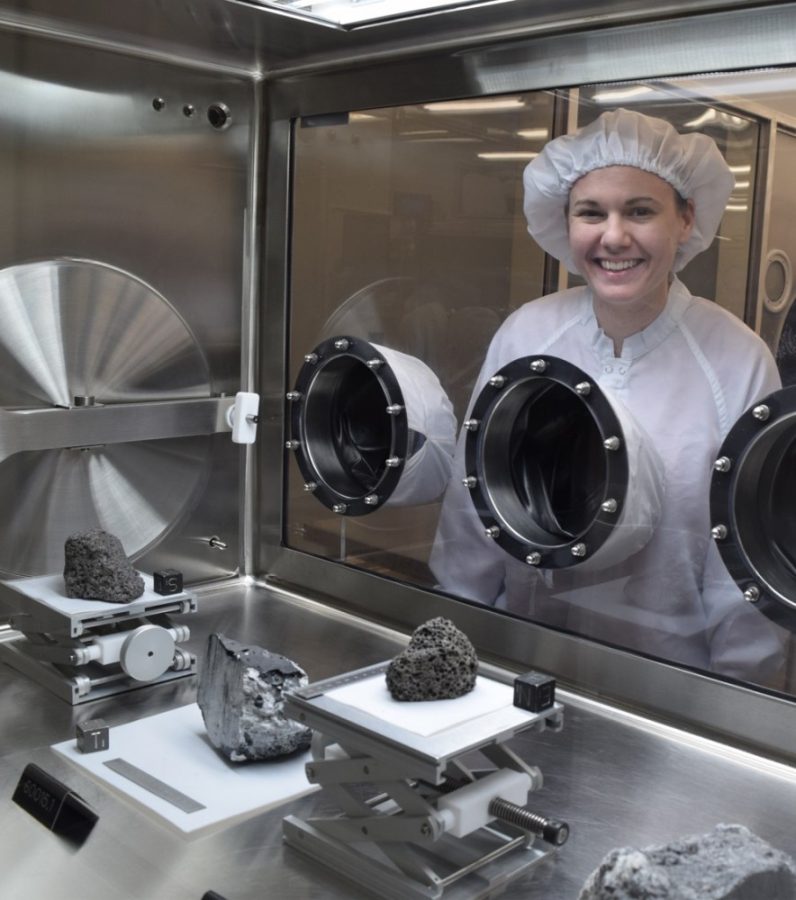Incoming University of Arizona assistant professor Jessica Barnes will lead a research team studying lunar samples that were originally collected during the 1972 NASA Apollo 17 mission.
The study will focus on how different curation and storage practices affect lunar samples. Barnes and her team will compare their lunar samples, stored at freezing temperatures and untouched since their original collection, with lunar samples kept at room temperature.
“This study will be really important for missions like OSIRIS-REx, because we are going to have to curate samples from those missions,” Barnes said. “We want to make sure that the practices we put in place to store these samples are not only ensuring the integrity of the samples for now but also thinking 50 years in the future.”
After nearly 50 years in storage, NASA began accepting applications for teams to study Apollo 17’s lunar samples. NASA kept these samples stored for so long because they wanted technology to evolve to be able to better analyze the samples before opening them to be studied.
RELATED: UA project chosen by NASA to aid in CubeSat Launch Initiative
Barnes will join the UA’s Lunar and Planetary Laboratory in the fall as an assistant professor. She is currently a postdoctoral fellow at NASA’s Johnson Space Center.
“I’ve been studying moon rocks for my almost seven- or eight-year career, and I knew that this study would be something really important, not just for my career, but also I wanted to be part of the Apollo legacy,” Barnes said. “I wasn’t old enough to see the Apollo missions, so this is my personal way of getting involved in the Apollo era.”
In college, Barnes first studied for an undergraduate degree in geoscience. As she moved to graduate school, she was interested in Earth science until an advisor introduced her to an advertisement for a lunar doctorate program.
“As soon as I read the advertisement, I was hooked. It was looking at moon rocks, it was using a brand new, cutting edge technique that now I am an expert in using,” Barnes said. “It was very serendipitous that I would go for something completely different and get the opportunity to do something that would shape my entire career so far.”
While Barnes’ research will focus more on the water content of the lunar samples, her co-investigator Carolyn Crow, research assistant at the University of Colorado Boulder, will focus on dating the samples.
“In order to link water content to a point in lunar history, we have to know the age,” Crow said. “That’s where I come in.”
According to Crow, this lunar sample study could be very valuable to the scientific community, as they are entering “the decade of sample returns.”
“There’s plans to go back to the moon within the next decade. There is a go-ahead for getting samples that are getting cached by Mars 2020. We have asteroid sample returns with OSIRIS-REx,” Crow said. “So there’s a practical aspect of this project with understanding what is the best way to handle these samples.”
RELATED: Q&A: UA researcher chosen for NASA’s SPHEREx mission
Barnes and Crow will be joined by a team of researchers, including Tom Zega, an associate professor at the UA Lunar and Planetary Laboratory.
“I’m thrilled that the University of Arizona will be a part of this new program. We’ve had researchers studying lunar samples more or less continually since the Apollo missions 50 years ago, but this program is particularly significant,” said Timothy Swindle, director of the UA Lunar and Planetary Laboratory. “In this case, we’ve got someone who wasn’t born when the Apollo missions happened … Yet [Barnes] can use the best tools available in 2019 to study samples from nearly 50 years ago.”
Follow Marquies White on Twitter















